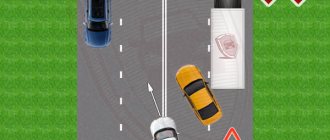Ticket 3 CD question 11
In what case can a driver start overtaking if such a maneuver is not prohibited on a given section of the road?
Overtaking is one of the most dangerous maneuvers a driver can do on the road. Before entering oncoming traffic before overtaking, the driver, of course, must take into account a number of factors, on which safety will directly depend
Ticket 2 CD
18-04-2019, 13:58
Overtaking rules
To avoid unpleasant consequences during overtaking, when starting it, you must adhere to some rules.
The legal rules for overtaking (where and when it is allowed, and where and when it is prohibited) are set out in section 11 of the traffic rules.
The so-called technical rules for overtaking are not officially listed anywhere. They have been formulated by general driving practice for a long time, and in modern realities, when the number of cars on the roads is growing, they constantly confirm their relevance.
The technical rules for overtaking consist of only three points:
- Maximum acceleration in your lane;
- Minimum possible time for driving in the oncoming lane;
- Return to your lane without interfering with the person being overtaken.
The listed points of the overtaking rules include, in fact, the beginning of overtaking, directly ahead of the overtaken person in the oncoming lane, and the completion of overtaking with a return to one’s half of the roadway.
Next, we will consider them in more detail, and at the same time we will pay attention to some mistakes when overtaking that motorists make when carrying out one or another maneuver in the process of overtaking.
Ticket 1 question 11
Is it possible for a passenger car driver to outrun trucks outside a populated area along such a trajectory?
Very often, when solving the presented question, cadets in the traffic rules exam proceed from the trajectory of movement that is offered to us. And it is very reminiscent of overtaking. But even in the wording of the question, and in the picture, by the way, there is an excellent hint - this
Ticket 2
13-12-2017, 08:48
Comments
Signs under numbers require repetition.
Sign 3.20 “Overtaking is prohibited” prohibits overtaking of all vehicles, except slow-moving ones, as well as horse-drawn carts, mopeds and two-wheeled motorcycles without sidecars. This vehicle is not a slow-moving vehicle, since it does not have a “Slow-moving vehicle” sign on the rear (Appendix 1, clause 8). (Correct answer: 3)
Category:
AVM
Ticket:
24
Question:
471
Correct answer:
3
Signs to the question
Sign 3.20 - No overtaking
More details
Ticket 3 question 11
In what case can a driver start overtaking if such a maneuver is not prohibited on a given section of the road?
Before overtaking, the driver must comply with a whole list of safety requirements and make sure that this maneuver will take place without “incidents”. In particular, first of all, you need to check (there are rear-view mirrors for this)
Ticket 4
13-12-2017, 08:47
Etiquette on the road when overtaking
At night, it is necessary to switch the headlights to low beam immediately at the moment when the leading car catches up with your vehicle in order to prevent it from being dazzled through the rear-view mirror.
It is recommended to flash your headlights briefly before maneuvering, demonstrating to oncoming cars that you are about to perform this maneuver.
When a vehicle enters the oncoming traffic zone to detour, given that the distance to you is quite safe, it begins to flash briefly, using the high beam.
This action signals that two or more cars are overtaking at the same time. This is especially necessary when visibility is limited, when it is difficult to estimate the distance to oncoming vehicles.
Today, overtaking is the most dangerous maneuver on the road. If it is performed incorrectly, you can create the risk of an emergency situation or even become the culprit of an accident, in which not only cars, but also people can suffer.
It is necessary to be disciplined on the road and treat all road traffic participants with respect. If you are not sure that you will be able to get ahead of the vehicle and then return to your side, then it is better not to try to do it.
Didn't find the answer to your question? Find out how to solve exactly your problem - call right now: +7 (Moscow) +7 (812) 309-53-42 (St. Petersburg) It's fast and free!
Free online consultation with a car lawyer
Didn't find the answer to your question? Find out how to solve exactly your problem - call right now: +7 (Moscow) +7 (812) 309-53-42 (St. Petersburg) It's fast and free!
Ticket 15 question 17
To attract the attention of the driver of an overtaken vehicle when driving outside a populated area during daylight hours, you can:
It is imperative to attract the attention of the driver of the car you are overtaking from the point of view of safety for both you and him. the fact is that many novice drivers have not yet brought some of their actions behind the wheel to automaticity. For example, the driver
Ticket 16
13-12-2017, 08:43
Overtaking on a turn
2nd article of 3 in the series Road situations. Cornering
Road situations. Cornering
- You can't brake while turning!
- Overtaking on a turn
- Oncoming overtaking on a bend
Traffic regulations prohibit overtaking on sharp turns (indicated by signs 1.11 and 1.12) for one simple reason - it is not always possible to see an oncoming car coming around the turn in a timely manner. Driving a car into the oncoming lane at such moments is very undesirable and very dangerous.
It is dangerous because when overtaking occurs at a bend in the road while two cars are passing each other, you can easily find yourself in a situation where you will not be able to complete the overtaking, and it is no longer possible to stop it. An emergency situation is created.
But this ban on overtaking in turns (Section 11.4 of the Traffic Regulations) applies only to sharp turns. Those. only on those curves of the road or its bends that are indicated by the corresponding road signs “Dangerous bend” or “Dangerous bends”. This prohibition does not apply to all other bends of the road.
The question arises: does it make sense to overtake on turns when it is not prohibited by traffic rules? The answer will likely depend on the case.
This is not an everyday question, but since this or that accident depends on the circumstances, any motorist may find himself in similar circumstances.
In this publication, using the example of a road situation, we will consider why you should not resort to overtaking at curves in the road, even if this maneuver on the road section is not prohibited by the rules.
Situation: Curving two-lane road. As the DVR moves, the road turns right. Filming is being done from a truck.
It's drizzling, a sign that the road may be slippery. In addition, despite properly functioning windshield wipers, popularly called “windshield wipers,” raindrops on the windshield always further impair visibility.
Ahead, around the bend, two oncoming cars appear relatively far away. A second later, it turns out that this passenger car has begun to overtake a tractor-trailer (“truck”), probably hoping to complete the overtaking before the road begins to curve, and before the “dash cam” passes.
At some point in time, a gray BMW appears in the frame, overtaking the DVR at very high speed, and then the “denouement” of the event itself.
Watch a short video.
Author of the video
What happened needs no comment. You can talk for a long time about the reasons for such actions, you can assume that there was an opportunity to do something differently - these are just assumptions. What happened happened.
But it makes sense to pay attention to antecedent facts in developing circumstances. If at least one of the participants in the accident had taken these facts into account in his assumptions, then the collision could have been avoided. We are talking about the curvature of the road and the peculiarities of perception of the situation on each side.
Below, in the picture is a view from the side of the recorder - the road curves to the right. On the left side in the direction of travel there are signs 1.34.1 “Direction of turn”. They are installed on small radius road curves with limited visibility.
The driver of the crossover also saw these signs, and probably understood that part of the road was not visible to him around the bend. In addition, paragraph 11.4 of the traffic rules prohibits overtaking in areas with limited visibility.
It was in his best interest to refuse to overtake until the road “straightened out” enough that he could see what was happening ahead.
For the driver of an oncoming car, the road curved to the left, which gave an erroneous impression of the safety of overtaking: the entire curve of the road was in front of his eyes, but the blind man had space behind the oncoming “truck.” This is exactly where the crossover came from. It made sense to hold off on overtaking.
Neither driver abandoned their intentions and decided to continue the maneuvers. Probably because they considered braking and returning to their lane unacceptable, or it was already too late.
What follows is almost a classic of the “genre”. The driver of a car who was overtaking an oncoming truck, instead of carefully “snuggling” with the truck driver, i.e. to his own, right side of the road, he decided to take cover on the oncoming side of the road.
It was there, only to the side of the road, (intuitively to the right) that the driver of the crossover hurried, where they “met”.
What conclusion can be drawn to avoid ending up in a similar situation?
In the article Overtaking at a dangerous turn, the issue of the legality of overtaking at curves in the road is considered.
It’s one thing when overtaking in a turn is prohibited by a sign or entering the oncoming lane is prohibited by markings. It’s another matter when nothing in these conditions prohibits driving into the oncoming lane, incl. and for overtaking.
Regardless of the circumstances on the turning arc, it makes sense to refuse overtaking altogether. Considering the speed of modern cars, an oncoming car approaches very quickly (oncoming speeds add up), especially if it appears unexpectedly, and it is easy for you, as the overtaking one, to find yourself at the point of no return. Next - depending on your luck.
One such case was published in the article Successfully Divorced.
In areas that have curves (no matter in which direction), the visibility of the road is almost always limited by something (terrain, vegetation, transport, etc.). For this reason, in different circumstances there is a high probability of misinterpreting the situation, for example, as in the case discussed above.
The drivers thought and assumed one option, but it turned out to be another.
When approaching a turn, or moving along the arc of a turn (bend) in the road, it is advisable to refuse to overtake in a turn, at least until the situation both in the oncoming lane and in your own lane allows you to perform the maneuver safely.
In addition to the above, I recommend that you read the material in the series of articles Overtaking and the articles Dangerous overtaking on a curved road, Successfully separated and Interrupted overtaking.
Be careful while driving.
Navigation through a series of articles<< You cannot brake in a turn! Oncoming overtaking on a turn >>











